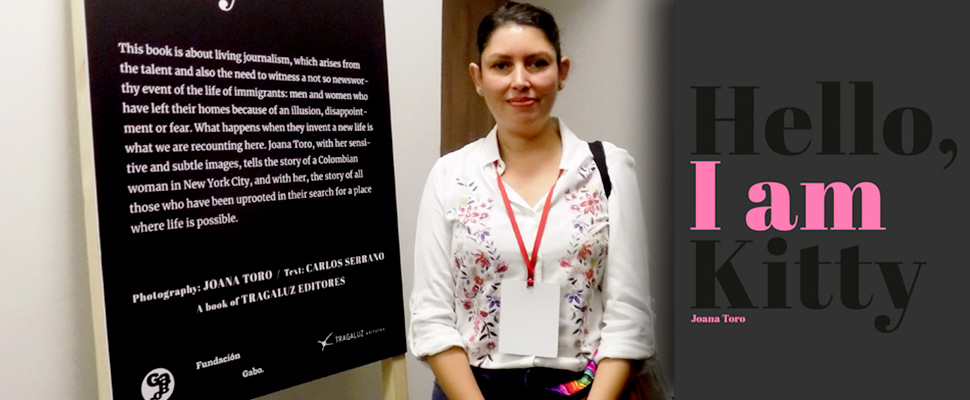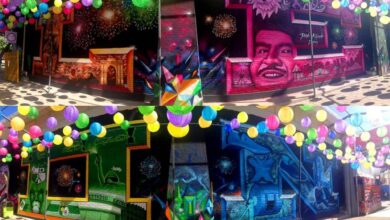‘Hello, I am Kitty’: The faces behind the Latino community in Times Square
"Mickey Mouse does not speak English" and "The Statue of Liberty is undocumented" are the phrases with which Joana Toro, a Colombian photographer, captivated New York.

Joana Toro, Colombian photographer presenting her book ‘Hello, I am Kitty’. / Photo: LatinAmerican Post
LatinAmerican Post | Carolina Rodríguez Monclou
Listen to this article
Leer en español: ‘Hello, I am Kitty’: Los rostros detrás de la comunidad latina de peluche en Times Square
Joana Toro traveled to the United States and met Marcela Joya, a roommate of the same nationality who told her about an idea: to perform with President Obama's dummy, dancing salsa in the heart of New York. Joana was attracted to the proposal so she decided to accompany her to take some photographs. However, being Joana's first time in Times Square, she was amazed by the number of lights, sounds, publicity and signs that surrounded the place. She looked around carefully and began to notice that those stuffed characters spoke Spanish.
Needing cash soon, Joana asked Berta, a Mexican who has been in business for over 15 years, if she could join what she calls "the stuffed community." Berta gave her the green light and that was how Joana immersed herself in that world, which, without knowing it, would become her great opportunity to show her potential as an independent photographer. Her journey would not only be published by The New York Times but would also be portrayed in the “Hello, I am Kitty” photobook.
LatinAmercian Post met with the author to inquire more about her experience as Hello Kitty for almost two years and her interest in Latin immigration in the United States.
Read also: The Joker: the movie is beautiful, painfully beautiful
LatinAmercian Post: What does “Hello, I am Kity” mean?
Joana Toro: The name of the book is an excuse. I use the "I am", to talk about others, and those others, offering themselves in the most colorful way, but at the same time being the most invisible characters for society.
LP: Which migrant behind the costume caught your attention the most and why?
JT: The migrant character that influenced me the most was Berta because she was the one who gave me the opportunity to work in Times Square. It was her who taught me and showed me the beauty and rudeness of this trade.
LP: Could you tell us a little more about Berta?
JT: She is an immensely wise, powerful and tough lady … she taught me many things.
LP: What disguise did Berta have?
JT: She had the costume of Hello Kitty, Mini Mouse, Mrs. Claus… I rented different types of costumes.
LP: Why did you choose Hello Kitty?
JT: Because the audience that accompanies Hello Kitty is mostly children, grandmothers, babies. It is a very beautiful audience. Also, she is a character with whom I identify, I like cats.
LP: How was that experience of taking photos inside the costume?
JT: The physical feeling of being in a costume is very relative. Personally, I feel very uncomfortable, I felt an impressive claustrophobia. These costumes are very striking and great. The heads are very heavy so the proportion of your own head with that of the doll already leaves you there as dizzy. You can only see through a small slot and it is a world of feelings. From shame to pride, I went through all kinds of emotions.
Read also: Justin Bieber and 5 other celebrities with exotic pets
LP: When did you start working as Hello Kitty?
JT: I started working as Hello Kity in Time Square in 2012, and I spent about a year and eight months working between seven and eight hours a day. The good thing about these tourist centers is that they are always full, so all seasons were good. Temperature changes are also experienced: extreme cold and overwhelming heat. The discomforts of being in this stuffed animal frame are complicated and especially when it is a job that does not depend on anyone but yourself, even the smallest thing like going to the bathroom becomes a challenge.
LP: What does it mean to be a Latino and undocumented migrant in the United States?
JT: It means being invisible, living with fear … but it also means strength, endurance, and resilience.
LP: Have you ever imagined how big this project would be?
JT: The first time I approach this stuffed community was for an economic purpose. I didn't understand how big it was in front of me. I entered an unknown world where I acquired as a "master" in migration and began to understand many things that I did not know. With the publication of this work in The New York Times, many doors opened. So, in a very natural way, I said "Mickey Mouse doesn't speak English" and "The Statue of Liberty is undocumented," then these phrases touched buttons in that community that I didn't know they had.
LP: What did this experience leave you?
JT: This was all an apprenticeship on the march … it still is. It is a huge responsibility to say something about what is happening. Migrants in the United States are an important electoral force, but there are much fear and misinformation. These types of projects help to remove prejudices about Latino immigrants such as being ignorant, criminals, that only serve to clean, and all those wrong situations that are heard. There may be bad apples within a community, but there are many more people doing positive things. So, yes, I feel a great responsibility regarding the immigration issue.
LP: Could you tell us about the debate that opened this work after its publication?
JT: A local discussion arose. There were people who said, "this community must leave, it is undocumented, it is dangerous, it does not let people walk, problems of public space, etc." Meanwhile, another part of the community in New York said: "they have every right to work because the first amendment is the right to express themselves, and the fact that they do not have documents does not prevent them from exercising this expression." New York City became a field of controversy, between those who supported the stuffed community and those who did not, and, well, the outcome will be seen in the book.





